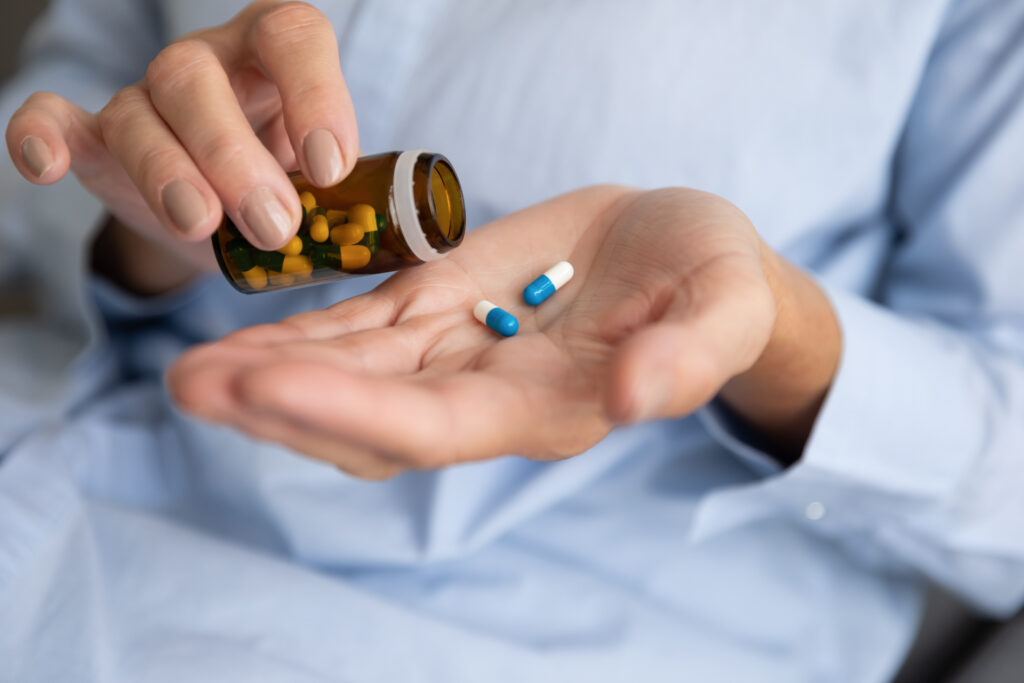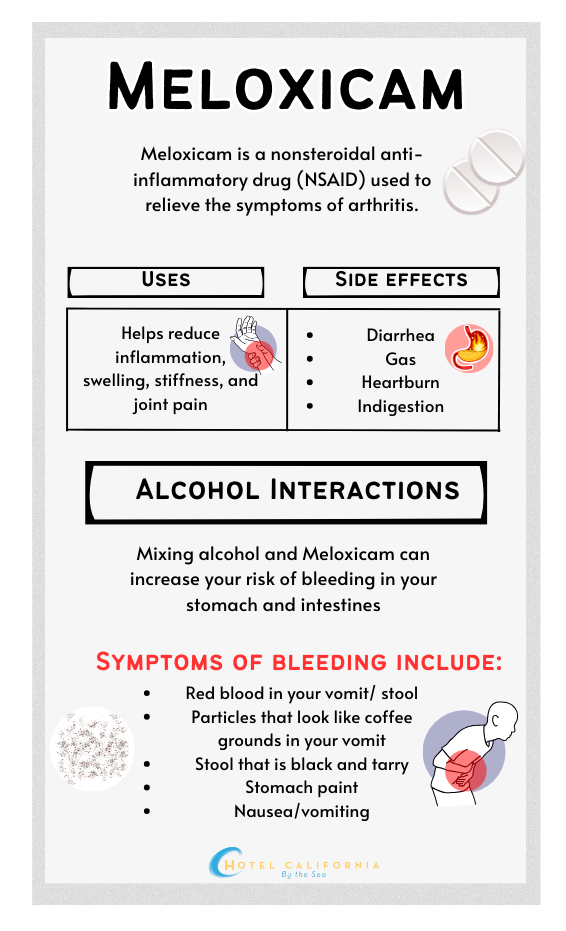Polysubstance Use: Meloxicam and Alcohol
Meloxicam, also known by the brand name Mobic, is a prescription medication used to treat pain and inflammation caused by certain types of arthritis. The nonsteroidal anti-inflammatory (NSAID) helps reduce painful symptoms caused by osteoarthritis, rheumatoid arthritis and juvenile idiopathic arthritis. An estimated 22.6 million prescriptions for meloxicam were issued by physicians in the U.S. Meloxicam is not a substance that is often abused. However, when it is taken in combination with alcohol, dependence can develop and cause dangerous and unpredictable side effects.

Meloxicam produces similar effects as corticosteroids without some of the side effects. It works by blocking the effects of the natural chemicals cyclooxygenase (COX) enzymes. These enzymes are a part of the building blocks of other chemicals in the body and develop in areas of injury or damage causing the person to feel pain and inflammation. It can also lower levels of prostaglandin, a hormone-like chemical that usually causes inflammation. The NSAID reduces the production of prostaglandins and inhibits the production of these COX enzyme chemicals, which in turn can result in a decrease in pain and inflammation.
With meloxicam use, users can typically see the full effects of the medication within two weeks of treatment. The drug can remain in the body for up to 24 hours after the initial dose. It is not recommended to drink alcohol while taking meloxicam. Users are recommended to wait until the medication has completely cleared the system before consuming alcohol to avoid dangerous and life-threatening side effects.
What conditions can Meloxicam treat?
- Osteoarthritis (OA). OA is a condition that causes cartilage around the bones in areas like joints, to break down. Cartilage is a protective tissue that surrounds and covers the ends of your bones. When cartilage breakdown begins to occur, it can cause the bones to rub up against each other leading to pain and stiffness. When this happens, there is no longer enough cartilage tissue to act as a soft buffer between two dense and hard bones. Common causes of OA include age, repeated stress on the joints over a long period of time, physical injury, obesity, and even poor posture.
- Rheumatoid arthritis (RA). RA is an autoimmune condition that also causes damage to joints between bones. An autoimmune condition is characterized by a person’s immune system mistakenly attacking its own body. In RA, the immune system will attack the lining of the joints causing the joints to lose their shape and executive function. Some of the major symptoms of RA include aching or pain, stiffness, swelling and tenderness.

Common side effects of Meloxicam
- Abdominal pain
- Diarrhea
- Nausea
- Dizziness
- Headache
- Heart attack and stroke
- Stomach and other GI conditions such as indigestion, bleeding, ulcers, holes in the digestive tract, a burning sensation in the chest or abdomen, dark or bloody stool and vomiting blood. Meloxicam can also irritate the lining of the stomach and intestines.
- Liver damage – liver inflammation and liver failure
- Increased blood pressure
- Kidney damage – can cause lower back pain and swelling of other parts of the body
Meloxicam and Alcohol
Meloxicam and alcohol are often used together. This polysubstance use can cause dangerous side effects. Many studies have shown alcohol consumption paired with an NSAID medication such as meloxicam can produce negative interactions. One of the most dangerous side effects of mixing meloxicam and alcohol is the impact on the liver. Both substances separately cause damage to the liver. When taken together, it can cause an overload in the liver, making it work twice as hard and can significantly increase the risk for liver damage and liver failure. Excessive amounts of meloxicam activity contribute to stress on the liver, which can compromise the organ’s ability to break down alcohol.
The combination of meloxicam and alcohol affects kidney health. The kidneys are in charge of filtering out waste and regulating blood pressure in the body. Meloxicam impacts renal blood flow and interrupts blood pressure regulation. Alcohol is a diuretic and can cause dehydration. Dehydration can hinder the process of waste elimination. When both substances are taken, it can hinder normal kidney functions.
Both substances impact gastrointestinal issues that are only compounded when the drugs are used concurrently. Excessive alcohol consumption weakens the gut and can cause issues such as gastritis. It damages the gut microbiome which can lead to ulcers, tears and bleeding of the stomach lining. It disrupts the body’s ability to absorb necessary nutrients and vitamins, which can lead to nutritional deficiencies. The combination of meloxicam and alcohol causes inflammation leading to ulcers in the gastrointestinal tract.
The cardiovascular system is also significantly affected by the polydrug use of meloxicam and alcohol. Users are at a much higher risk for heart attack and stroke. Both drugs impact heart functions and when they are used together can cause greater stress and strain on the organ leading to heart failure and the risk of stroke.
Check Your Insurance Coverage for FREE
Find out if your insurance covers addiction treatment in minutes. We accept most insurance!
Other side effects of mixing Meloxicam and Alcohol
- Psoriasis arthritis in women
- It can interfere with blood thinning functions causing the inability of blood to clot
- Gout – Alcohol can cause flare-ups in joint pain and cancels out the pain relief that meloxicam provides. The combination of the two drugs can actually worsen and increase swelling and inflammation of arthritis.
- Sedation
- Dizziness and drowsiness
- Impaired coordination
- Constipation or diarrhea
- Nausea
- Risk of overdose which includes symptoms such as chest or throat pain, severe stomach pain, seizure, lack of energy, blue lips, sudden weight loss and coma.
Reach out to Hotel California by the Sea
We specialize in treating addiction and other co-occurring disorders, such as PTSD. Our Admissions specialists are available to walk you through the best options for treating your addiction.
Treatment for Substance Use Disorder
Meloxicam and alcohol are both central nervous system depressants. When used in conjunction with each, it can intensify sedative effects as well as dangerously impact functions of other organs such as the heart, stomach, liver and kidney. When meloxicam is used on its own, there is very little risk of dependence on the NSAID. However, combined with other addictive substances such as alcohol, it can lead to a higher risk for abuse, tolerance and addiction.
Alcohol abuse significantly increases the risk of serious side effects of meloxicam which include fever, chest pain, sudden weight gain, high blood pressure, stomach bleeding, liver damage and kidney damage. Treatment of polysubstance abuse can be effectively treated through a behavioral health treatment program such as Hotel California by the Sea.
We offer treatment in all levels of care including detox, inpatient residential, partial hospitalization program and intensive outpatient programs. Throughout each level of care, clients will also receive rigorous therapeutic treatments. These evidence-based therapies include CBT, DBT and group therapy. Effectively addressing addiction means to address every aspect of the disease. Hotel California by the Sea is dedicated to helping clients in all stages of recovery to overcome their addiction.
References:
https://www.healthline.com/health/drugs/meloxicam-tablet#_noHeaderPrefixedContent
https://alcoholrehabhelp.org/interactions/meloxicam
https://addictionresource.com/drugs/meloxicam/and-alcohol
https://www.rehab4addiction.co.uk/guides/meloxicam-alcohol
https://www.healthdigest.com/1250974/avoid-alcohol-meloxicam
https://www.medicalnewstoday.com/articles/meloxicam-oral-tablet#side-effects
